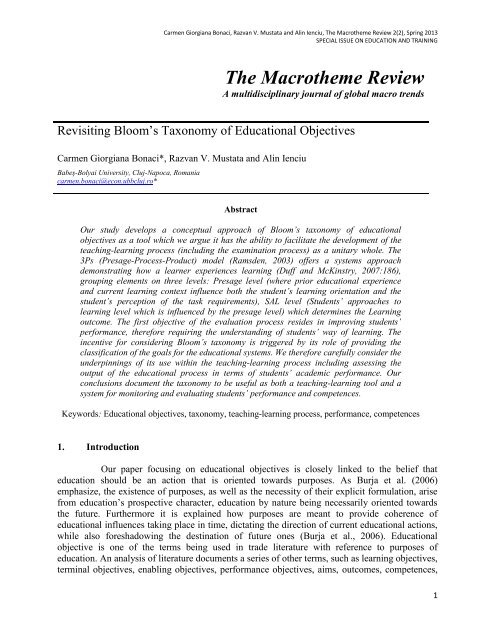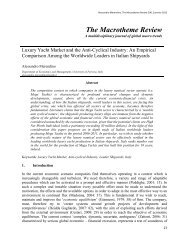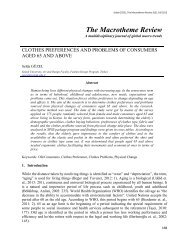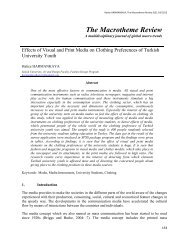Revisiting Bloom's Taxonomy of Educational Objectives
Revisiting Bloom's Taxonomy of Educational Objectives
Revisiting Bloom's Taxonomy of Educational Objectives
Create successful ePaper yourself
Turn your PDF publications into a flip-book with our unique Google optimized e-Paper software.
Carmen Giorgiana Bonaci, Razvan V. Mustata and Alin Ienciu, The Macrotheme Review 2(2), Spring 2013<br />
SPECIAL ISSUE ON EDUCATION AND TRAINING<br />
The Macrotheme Review<br />
A multidisciplinary journal <strong>of</strong> global macro trends<br />
<strong>Revisiting</strong> Bloom’s <strong>Taxonomy</strong> <strong>of</strong> <strong>Educational</strong> <strong>Objectives</strong><br />
Carmen Giorgiana Bonaci*, Razvan V. Mustata and Alin Ienciu<br />
Babeş-Bolyai University, Cluj-Napoca, Romania<br />
carmen.bonaci@econ.ubbcluj.ro*<br />
Abstract<br />
Our study develops a conceptual approach <strong>of</strong> Bloom’s taxonomy <strong>of</strong> educational<br />
objectives as a tool which we argue it has the ability to facilitate the development <strong>of</strong> the<br />
teaching-learning process (including the examination process) as a unitary whole. The<br />
3Ps (Presage-Process-Product) model (Ramsden, 2003) <strong>of</strong>fers a systems approach<br />
demonstrating how a learner experiences learning (Duff and McKinstry, 2007:186),<br />
grouping elements on three levels: Presage level (where prior educational experience<br />
and current learning context influence both the student’s learning orientation and the<br />
student’s perception <strong>of</strong> the task requirements), SAL level (Students’ approaches to<br />
learning level which is influenced by the presage level) which determines the Learning<br />
outcome. The first objective <strong>of</strong> the evaluation process resides in improving students’<br />
performance, therefore requiring the understanding <strong>of</strong> students’ way <strong>of</strong> learning. The<br />
incentive for considering Bloom’s taxonomy is triggered by its role <strong>of</strong> providing the<br />
classification <strong>of</strong> the goals for the educational systems. We therefore carefully consider the<br />
underpinnings <strong>of</strong> its use within the teaching-learning process including assessing the<br />
output <strong>of</strong> the educational process in terms <strong>of</strong> students’ academic performance. Our<br />
conclusions document the taxonomy to be useful as both a teaching-learning tool and a<br />
system for monitoring and evaluating students’ performance and competences.<br />
Keywords: <strong>Educational</strong> objectives, taxonomy, teaching-learning process, performance, competences<br />
1. Introduction<br />
Our paper focusing on educational objectives is closely linked to the belief that<br />
education should be an action that is oriented towards purposes. As Burja et al. (2006)<br />
emphasize, the existence <strong>of</strong> purposes, as well as the necessity <strong>of</strong> their explicit formulation, arise<br />
from education’s prospective character, education by nature being necessarily oriented towards<br />
the future. Furthermore it is explained how purposes are meant to provide coherence <strong>of</strong><br />
educational influences taking place in time, dictating the direction <strong>of</strong> current educational actions,<br />
while also foreshadowing the destination <strong>of</strong> future ones (Burja et al., 2006). <strong>Educational</strong><br />
objective is one <strong>of</strong> the terms being used in trade literature with reference to purposes <strong>of</strong><br />
education. An analysis <strong>of</strong> literature documents a series <strong>of</strong> other terms, such as learning objectives,<br />
terminal objectives, enabling objectives, performance objectives, aims, outcomes, competences,<br />
1
Carmen Giorgiana Bonaci, Razvan V. Mustata and Alin Ienciu, The Macrotheme Review 2(2), Spring 2013<br />
SPECIAL ISSUE ON EDUCATION AND TRAINING<br />
instructional objectives or behavioural objectives, that are used with similar meaning, though<br />
some differences certainly exist. A simple manner <strong>of</strong> approaching educational objectives would<br />
be to just see them as expressions <strong>of</strong> what an educator hopes the learner can accomplish as a<br />
results <strong>of</strong> the teaching-learning process.<br />
Furthermore, when designing educational objectives we must consider they should be<br />
relevant in terms <strong>of</strong> confirming the learner’s needs and institutional objectives, observable,<br />
measurable, logical, unequivocal and feasible when considering the resources that are available.<br />
While representing an expression <strong>of</strong> the purposes <strong>of</strong> the educational process, educational<br />
objectives also serve purposes closely linked to designing the teaching-learning process by<br />
facilitating course planning, communicating desirable emphasis <strong>of</strong> treatment, enhancing<br />
curriculum design and facilitating evaluation. <strong>Educational</strong> objectives are <strong>of</strong> significant help when<br />
considering curriculum planning, analysis and updating, gathering feedback through measurable<br />
indicator, as well as informing learners. Designing educational objectives should therefore always<br />
be developed by first considering the desired end result.<br />
<strong>Educational</strong> objectives should be seen as policy statements <strong>of</strong> direction that provide<br />
foundation for the entire educative structure. Regardless <strong>of</strong> the particular course we might be<br />
thinking <strong>of</strong>, we should always try to first ensure it has an internally consistent structure. In this<br />
regard an alignment is necessary between objectives, assessment and instructional strategies.<br />
While objectives state what we want the learner to acquire, assessment allows the educator to<br />
check to what extant the learner meets the objectives. It is through instructional strategies that the<br />
educator provides for the teaching-learning process meant to guide the learner towards the above<br />
mentioned objectives. The above mentioned alignment must be consider in the context that<br />
makes it possible for each one <strong>of</strong> the components to change, transforming it into a dynamic<br />
process as reflected through the following figure:<br />
Figure 1: Alignment for an internally consistent structure<br />
Source: (Carnegie Mellon, 2012 1 )<br />
1 Figure available at http://www.cmu.edu/teaching/designteach/design/learningobjectives.html, accessed December<br />
21, 2012.<br />
2
Carmen Giorgiana Bonaci, Razvan V. Mustata and Alin Ienciu, The Macrotheme Review 2(2), Spring 2013<br />
SPECIAL ISSUE ON EDUCATION AND TRAINING<br />
We therefore argue that educational objectives should be considered through their role<br />
<strong>of</strong> supporting the teaching-learning process. Moreover, it is necessary to distinguish objectives<br />
from goals. While the latter should be seen as broad statement, general intentions that are rather<br />
abstract and more difficult to measure, objectives should be specific, precise, concrete and<br />
measurable. If the goal <strong>of</strong> a learning activity is like a target, the objectives can be defined as the<br />
arrows that help the learner reach that target.<br />
2. Taxonomies: background and evolutions<br />
The development and use <strong>of</strong> educational objectives is known to have arisen as a way to<br />
conceptualize instruction and training programs in the military, but was quickly adopted by<br />
educational psychologists and educators (the Academy <strong>of</strong> Dental Therapeutics and<br />
Stomatology 2 ). It was in 1956 that Benjamin Bloom and his colleagues published a taxonomy <strong>of</strong><br />
educational objectives or taxonomy <strong>of</strong> learner behaviors. The taxonomy influenced curriculum<br />
development and enhanced the shift towards competency based instruction. While several<br />
changes affected Bloom’s original taxonomy that was subsequently revised and updated,<br />
nowadays we are witnessing the wide use <strong>of</strong> educational objectives throughout the life long<br />
educational process, including continuing pr<strong>of</strong>essional education activities. Before developing<br />
our framework that argues for the benefits <strong>of</strong> implementing Bloom’s taxonomy within the<br />
educational process at university level, we will develop a brief analysis <strong>of</strong> taxonomies <strong>of</strong><br />
educational objectives. A first step in this regard requires the clarification <strong>of</strong> term taxonomy.<br />
A taxonomy <strong>of</strong> educational objectives comprises the systematized whole <strong>of</strong> objectives per<br />
levels, fields and categories. Burja et al. (2006) point out that different levels and categories <strong>of</strong><br />
finalities <strong>of</strong> education do not represent separate entities, but form a structured whole, a<br />
systematized ensemble within which each finality has a certain hierarchic positioning and reflects<br />
a certain field <strong>of</strong> the project aimed through education. While there are many manners and criteria<br />
to construct taxonomy, practice documents two main types <strong>of</strong> taxonomies (Burja et al., 2006):<br />
as:<br />
Taxonomies that are organized vertically: systemizing the objectives based on<br />
their level <strong>of</strong> generality;<br />
Taxonomies that are organized per domain: systemizing the objectives based<br />
on the main domains that define a forming pr<strong>of</strong>ile: cognitive, affective and<br />
psychomotor.<br />
Literature provides other types <strong>of</strong> taxonomies by considering classification criteria such<br />
Type <strong>of</strong> objectives: institutional, departmental (intermediate) and specific<br />
instructional / behavior;<br />
The person: teacher centered and student centered.<br />
Burja et al. (2006) explain how developing a taxonomy <strong>of</strong> educational objectives finally<br />
leads to a hierarchical system <strong>of</strong> purposes and objectives that requires internal coherence and<br />
correct articulation <strong>of</strong> different levels and steps <strong>of</strong> passing from general to particular,<br />
emphasizing three generally accepted levels in defining educational objectives, as documented<br />
2 Information available at http://www.ineedce.com/courses/1561/PDF/ed_goals_objctvs.pdf , accessed December 21,<br />
2012.<br />
3
Carmen Giorgiana Bonaci, Razvan V. Mustata and Alin Ienciu, The Macrotheme Review 2(2), Spring 2013<br />
SPECIAL ISSUE ON EDUCATION AND TRAINING<br />
through trade literature: the general level <strong>of</strong> objectives (or general purposes, aims or ideals <strong>of</strong><br />
education, representing the most general expression <strong>of</strong> social requests at one moment in time and<br />
perspective social aspirations), the intermediary level <strong>of</strong> objectives (achieving a first translation<br />
<strong>of</strong> the general purposes into particular terms, generally aiming different educational steps and<br />
pr<strong>of</strong>iles, sides <strong>of</strong> the educational process and classes) and the actual (concrete) level <strong>of</strong> objectives<br />
(within which objectives are transposed in terms <strong>of</strong> learner’ performances, usually through<br />
observable behavior (or whose presence can be recorded in some manner) that can be measured<br />
and assessed). A quite similar vertical organization <strong>of</strong> educational objectives is that presented by<br />
Radu (1981 cited by Burja et al. 2006) who discusses the following levels in defining educational<br />
objectives: general finalities, purposes, intermediary objectives and operational objectives. De<br />
Cecco (1977 cited by Burja et al. 2006) puts forward a different perspective by distinguishing<br />
between school objectives, the educator’s objectives and the learner’s objectives, therefore<br />
reflecting the manner in which educational objectives polarize on the social-individual axis.<br />
Moving forward towards taxonomies that are organized per domain, we first have to<br />
clarify what each <strong>of</strong> the three above mentioned domains cover. The cognitive domain deals with<br />
intellectual abilities and covers a significant part <strong>of</strong> the educational objectives, sometimes called<br />
head objectives. The affective domain relates to expressing feelings, emotions, beliefs, values,<br />
fears, interests, attitudes, covering objectives that can <strong>of</strong>ten be the most difficult to develop,<br />
sometimes called heart objectives. The psychomotor domain covers objectives that are generally<br />
easy to establish (motor skills) due to behavior being easier to observe and monitor, sometimes<br />
called hand objectives. All three domains are hierarchical, positioning more complex and higher<br />
level skills at the top and fundamentals at the earliest levels, with each level building on itself and<br />
assuming mastery at the lower levels. Burja et al. (2006) also underline the fact that specifying<br />
objectives per domain represents a necessary step towards developing operational objectives. We<br />
will further synthesize the main taxonomies that were developed in literature for the three<br />
domains:<br />
4
Carmen Giorgiana Bonaci, Razvan V. Mustata and Alin Ienciu, The Macrotheme Review 2(2), Spring 2013<br />
SPECIAL ISSUE ON EDUCATION AND TRAINING<br />
Table 1. Taxonomies that are organized per domain<br />
Domain <strong>Taxonomy</strong> Synthesis<br />
Cognitive B. Bloom It categorizes a continuum <strong>of</strong> educational objectives described<br />
in terms <strong>of</strong> learner - centred actions that represent the kind <strong>of</strong><br />
knowledge and intellectual engagement we want the learner to<br />
display. It consists <strong>of</strong> six levels <strong>of</strong> objectives, each <strong>of</strong> which is<br />
divided into subcategories. The levels being covered are as<br />
follows: knowledge, comprehension, application, analysis,<br />
synthesis, evaluation.<br />
L. d’Hainaut Defines three levels <strong>of</strong> hierarchical cognitive operations based<br />
on their complexity: particular (specific) operations, simple<br />
operations and complete (or combined) operations. It is based<br />
on hierarchical cognitive operations, comprising the following<br />
cognitive activities presented in the order <strong>of</strong> their complexity:<br />
reproduction, conceptualization, cognitive application,<br />
Affective N. Metfessel<br />
exploration, mobilization, problem solving.<br />
Although Bloom did not focus on the objectives belonging to<br />
the affective domain, his taxonomy also comprised such<br />
objectives, the most well-known version being that <strong>of</strong> the<br />
affective operational objectives developed by Metfessel,<br />
comprising: reception, answer, valuation, organization,<br />
Psychomotor A. Harrow<br />
characterization.<br />
The taxonomy comprises: reflex movements, natural or<br />
fundamental movements, perceptive aptitudes, physical<br />
aptitudes, motor skills, non-verbal communication.<br />
Source: (authors’ projection based on Burja et al. 2006)<br />
For the purpose <strong>of</strong> our paper we will further detail the presentation in the case <strong>of</strong> Bloom’s<br />
taxonomy being initially developed by B. Bloom in 1956 and further revised and updated. One <strong>of</strong><br />
the well-known updated versions is that by Anderson and Krathwohl (2001). In 1956, a<br />
committee <strong>of</strong> College and University examiners published the Classification <strong>of</strong> <strong>Educational</strong><br />
Goals under the name <strong>of</strong> <strong>Taxonomy</strong> <strong>Educational</strong> <strong>Objectives</strong>: The Classification <strong>of</strong> <strong>Educational</strong><br />
Goals. Handbook 1. Cognitive domain, having Benjamin S. Bloom from the University <strong>of</strong><br />
Chicago as editor. Bloom clearly emphasizes the purpose <strong>of</strong> such a taxonomy, as follows: It is<br />
expected to be <strong>of</strong> general help to all teachers, administrators, pr<strong>of</strong>essional specialists, and<br />
research workers who deal with curricular and evaluation problems. It is especially intended to<br />
help them discuss these problems with greater precision (Bloom, 1956, p.1 cited by Bonaci et al.<br />
2011). The original taxonomy <strong>of</strong> educational objectives related to the cognitive domain is<br />
structured on two levels: Knowledge and Intellectual abilities and skills (Bonaci et al. 2011).<br />
While the first level, Knowledge, involves the recall <strong>of</strong> specifics and universals, the recall <strong>of</strong><br />
methods and processes, or the recall <strong>of</strong> a pattern, structure, or setting (Bloom, 1956, p. 201), the<br />
second level, Intellectual abilities and skills, refer to organized modes <strong>of</strong> operation and<br />
generalized techniques for dealing with materials and problems (Bloom, 1956, p. 201).<br />
Knowledge is defined as the remembering <strong>of</strong> previously learned material, representing the lowest<br />
level <strong>of</strong> learning and involving recalling or reciting: facts, observations, or definitions.<br />
Intellectual abilities and skills refers to the mental process <strong>of</strong> organizing and working with the<br />
5
Carmen Giorgiana Bonaci, Razvan V. Mustata and Alin Ienciu, The Macrotheme Review 2(2), Spring 2013<br />
SPECIAL ISSUE ON EDUCATION AND TRAINING<br />
materials and problems in order to achieve a purpose assuming five sub-levels as presented below<br />
(Soderholm, 2005 3 ):<br />
Comprehension: defined as the ability to grasp the meaning <strong>of</strong> material,<br />
representing the lowest level <strong>of</strong> understanding and involving explaining,<br />
interpreting, or translating;<br />
Application: refers to the ability to use learned material in new and concrete<br />
situations, requiring higher level <strong>of</strong> understanding than comprehension and<br />
involving applying: rules, methods, laws, principles;<br />
Analysis: refers to the ability to break down material into its component parts<br />
so that its organizational structure may be understood, representing a higher<br />
level than previous categories because <strong>of</strong> requirement <strong>of</strong> understanding <strong>of</strong> both<br />
the content and structural form <strong>of</strong> the material and involving analyzing<br />
relationships, distinguishing between facts and inferences, evaluating data<br />
relevance;<br />
Synthesis: refers to the ability to put parts together to form a new whole,<br />
representing creative behaviours, with emphasis on the formulation <strong>of</strong> new<br />
patterns or structures and involving proposing plans, writing speeches, creating<br />
classification schema;<br />
Evaluation: is concerned with the ability to judge the value <strong>of</strong> material for a<br />
given purpose, representing the highest level because <strong>of</strong> inclusion <strong>of</strong> elements<br />
<strong>of</strong> all other categories plus conscious value judgments based on criteria and<br />
involving judging logical consistency, adequacy <strong>of</strong> data support for<br />
conclusions.<br />
The taxonomy developed by Anderson and Krathwohl (2001) renounces to use the<br />
noun in describing the levels and replaces it with the verb form and also switches the place <strong>of</strong> the<br />
last two levels as synthesized in the following table reflecting the main chances to Bloom’s<br />
taxonomy:<br />
3 Synthesis available at http://web.mit.edu/tll/teaching-materials/learning-objectives/taxonomies.html, accessed<br />
December 22, 2012.<br />
6
Carmen Giorgiana Bonaci, Razvan V. Mustata and Alin Ienciu, The Macrotheme Review 2(2), Spring 2013<br />
SPECIAL ISSUE ON EDUCATION AND TRAINING<br />
Table 2. Bloom 1956 vs. Anderson and Krathwohl 2001 4<br />
No. Bloom 1956 Anderson and Krathwohl<br />
2001<br />
1 Knowledge Remember<br />
2 Comprehension Understand<br />
3 Application Apply<br />
4 Analysis Analyze<br />
5 Synthesis Evaluate<br />
6 Evaluation Create<br />
Source: (authors’ projection based on Bloom, 1956 and Anderson and Krathwohl, 2001)<br />
The following section <strong>of</strong> our paper puts forward a framework for implementing<br />
Bloom’s taxonomy within the teaching-learning process, drawing from the analysis developed by<br />
Bonaci et al. (2011) on the particular case <strong>of</strong> an accounting class taught within the Faculty <strong>of</strong><br />
Economics and Business Administration <strong>of</strong> the Babeş-Bolyai University in Romania.<br />
3. Proposed framework<br />
The starting point <strong>of</strong> the proposed framework relies on the 1956 committee working<br />
on what we nowadays call Bloom taxonomy scope which was to develop a taxonomy <strong>of</strong><br />
educational objectives that would provide the classification <strong>of</strong> the goals for the educational<br />
systems. We therefore go back to the idea that objectives should represent arrows helping us<br />
reach the goal target. Our framework proposes the use <strong>of</strong> Bloom’s taxonomy within the teachinglearning<br />
process including assessing the output <strong>of</strong> the educational process in terms <strong>of</strong> students’<br />
academic performance. A first step in this regard implies courses and seminars to be structured<br />
based on the taxonomy. The learner should be asked to read the materials assigned for the classes<br />
in advance, while also being assigned with homework involving around three problems or<br />
exercises per week. The cope <strong>of</strong> the seminar would be to check the comprehension <strong>of</strong> the material<br />
assigned to be read and to apply the theory to a specific situation. Courses could be designed to<br />
exercise students’ abilities to analyze, synthesize and evaluate a given case study. The courses<br />
should precede seminars in order to allow the learning process to follow the hierarchy within the<br />
taxonomy. Bloom’s taxonomy should further be used in developing the examination process<br />
aiming to assess the output <strong>of</strong> the educational process in terms <strong>of</strong> students’ academic<br />
performance. The above presented approach considers the university context, but we encourage<br />
the taxonomy to be considered throughout the life long educational process, <strong>of</strong>fering alternatives<br />
to consider population related particularities as discussed by Smrčka and Arltová (2012).<br />
Defining the educational objectives for a course could be done by using the following<br />
table considering the updated versions <strong>of</strong> Anderson and Krathwohl (2001):<br />
4 No. reflects the hierarchical positioning <strong>of</strong> the levels.<br />
7
The Knowledge<br />
Dimension<br />
A. Factual knowledge<br />
B. Conceptual<br />
knowledge<br />
C. Procedural<br />
knowledge<br />
D. Meta-cognitive<br />
knowledge<br />
Carmen Giorgiana Bonaci, Razvan V. Mustata and Alin Ienciu, The Macrotheme Review 2(2), Spring 2013<br />
SPECIAL ISSUE ON EDUCATION AND TRAINING<br />
Table 3. Bloom’s taxonomy table<br />
The Cognitive Process Dimension<br />
1. Remember 2. Understand 3. Apply 4. Analyze 5. Evaluate 6. Create<br />
Source: (Carnegie Mellon, 2012 5 )<br />
An important element <strong>of</strong> the proposed framework relies on articulating the teachinglearning<br />
process by using the taxonomy both throughout the semester and in assessing the output<br />
<strong>of</strong> the educational process in terms <strong>of</strong> learners’ (students’) (academic) performance. This would<br />
allow for the development <strong>of</strong> further analyses considering how the grade (as a reflection <strong>of</strong><br />
students’ performance) was formed based on the levels in Bloom’s hierarchy. This would provide<br />
empirical evidence on students’ achievements in relation to the levels considered in the<br />
taxonomy. Furthermore, planning could be done by considering the study program<br />
(undergraduate, master program, research oriented, pr<strong>of</strong>essional oriented, long distance etc.) and<br />
its objectives.<br />
4. Concluding remarks<br />
Our paper develops a conceptual approach <strong>of</strong> Bloom’s taxonomy <strong>of</strong> educational<br />
objectives as a tool which we argue it has the ability to facilitate the development <strong>of</strong> the teachinglearning<br />
process (including the examination process) as an articulated unitary whole. The<br />
incentive for considering Bloom’s taxonomy is triggered by its role <strong>of</strong> providing the classification<br />
<strong>of</strong> the goals for the educational systems. Our conclusions document the taxonomy to be useful as<br />
both a teaching-learning tool and a system for monitoring and evaluating students’ performance<br />
and competences. The paper discusses the importance <strong>of</strong> educational objectives, synthesizes<br />
existent taxonomies and develops a detailed analysis <strong>of</strong> Bloom’s taxonomy. Key-points to how<br />
the taxonomy could be implemented within nowadays’ educational environment by considering<br />
the entire teaching-learning process are identified. A main limitation <strong>of</strong> the proposed framework<br />
consists in the fact that comparison between students’ performance when applying the taxonomy<br />
with other approaches is not possible since the same educational context can not be created twice.<br />
Still, we encourage the application <strong>of</strong> the proposed framework by emphasizing the benefits <strong>of</strong> the<br />
analyses that could be developed, as explained in section 3.<br />
5 Table available at<br />
http://www.cmu.edu/teaching/resources/Teaching/CourseDesign/TeacherAssessment/taxonomyTable.pdf, accessed<br />
December 22, 2012.<br />
8
Carmen Giorgiana Bonaci, Razvan V. Mustata and Alin Ienciu, The Macrotheme Review 2(2), Spring 2013<br />
SPECIAL ISSUE ON EDUCATION AND TRAINING<br />
Acknowledgement<br />
This work was supported from the European Social Fund through Sectoral Operational<br />
Programme Human Resources Development 2007-2013, project number POSDRU<br />
86/1.2/S/53849/ “Aplicarea unui sistem de competenţe coerent cu cel european la nivelul<br />
masteratelor în domeniul analizei economice şi evaluării de active şi afaceri”, Babeş-Bolyai<br />
University, Cluj-Napoca being the main beneficiary and coordinator <strong>of</strong> the partners within the<br />
project.<br />
References<br />
Anderson, L. W., Krathwohl, D. R. et al (Eds.) (2001), A <strong>Taxonomy</strong> for Learning, Teaching, and<br />
Assessing: A Revision <strong>of</strong> <strong>Bloom's</strong> <strong>Taxonomy</strong> <strong>of</strong> <strong>Educational</strong> <strong>Objectives</strong>, Allyn & Bacon, Boston,<br />
MA (Pearson Education Group).<br />
Bloom B.S., (1956), <strong>Taxonomy</strong> <strong>of</strong> <strong>Educational</strong> <strong>Objectives</strong>, Handbook 1. Cognitive domain,<br />
Longman Green and Co LTD, London.<br />
Bloom. B., Krathwolh,D. (1956), <strong>Taxonomy</strong> <strong>of</strong> <strong>Educational</strong> <strong>Objectives</strong>: The Classification <strong>of</strong><br />
<strong>Educational</strong> Goals , New York, Longmans.<br />
Bonaci, C.G., Mustata, R. V., Muţiu, A.I., Matiş D. (2011), Accounting Students’ Academic<br />
Performance: a Battle between Perceptions? A Romanian Research Note, Proceedings <strong>of</strong> the 6th<br />
International Conference Accounting and Management Information Systems, p. 861 – 879.<br />
Burja, V., Voiculescu, F., Burja, C., Voiculescu, E. (2006), Didactica ştiinţelor economice,<br />
Irecson Publishing House, Bucharest, p. 1 – 285.<br />
De Cecco, J.P. (1977), Obiectivele instrucţionale, in Caiete de pedagogie modernă, vol. 6,<br />
Probleme de tehnologie didactică, eds. Noveanu, E.P., Didactică şi Pedagogică Publishing House,<br />
Bucharest.<br />
Duff A., McKinstry S. (2007), Student’s Approaches to Learning, Issues in Accounting<br />
Education, Vol. 22, No. 2, p.183-214.<br />
Radu, I.T. (1981), Teorie şi practică în evaluarea eficienţei învăţământului, Didactică şi<br />
Pedagogică Publishing House, Bucharest.<br />
Ramsden P. (2003), Learning to Teach in Higher Education, 2 nd edition. London, U.K.<br />
Routledge.<br />
Smrčka, L., Arltová, M. (2012), Economic Aspects <strong>of</strong> Population Ageing in Developed<br />
Countries, Politická ekonomie, Vol. 60, No. 1, p. 113-132.<br />
9





